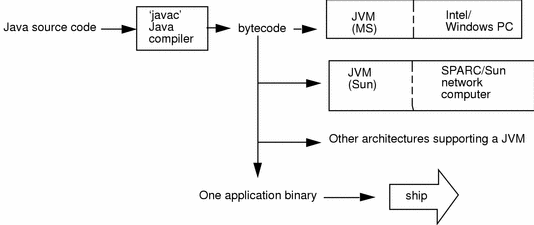JVM
The JVM is an abstract computing machine, having an instruction set that uses memory. Virtual machines are often used to implement a programming language. The JVM is the cornerstone of the Java programming language. It is responsible for Java's cross-platform portability and the small size of its compiled code.
The Solaris JVM is used to execute Java applications. The Java compiler, javac, outputs bytecodes and puts them into a .class file. The JVM then interprets these bytecodes, which can then be executed by any JVM implementation, thus providing Java's cross-platform portability. The next two figures illustrate the traditional compile-time environment and the new portable Java compile-time environment.
Figure 1-2 Traditional Compile-Time Environment

Figure 1-3 New Portable Java Compile-Time Environment

Multithreading JVM
The Java programming language requires that multithreading (MT) programs be supported (see Chapter 2, Multithreading). All Java interpreters provide an MT programming environment. However, many of these interpreters support only uniprocessor multithreading, so Java program threads are executed one at a time.
The Solaris JVM interpreter takes full advantage of multiprocessor systems by using the intrinsic Solaris multithread facilities. These allow multiple threads of a single process to be scheduled simultaneously onto multiple CPUs. An MT Java program run under the Solaris JVM will have a substantial increase in concurrency over the same program run on other platforms.
- © 2010, Oracle Corporation and/or its affiliates
